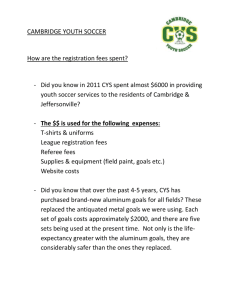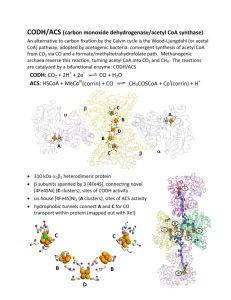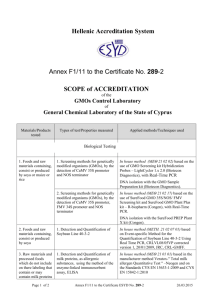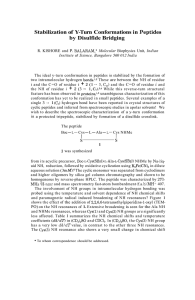Bacillus thuringiensis thuringiensis J. Biosci., Printed in India
advertisement
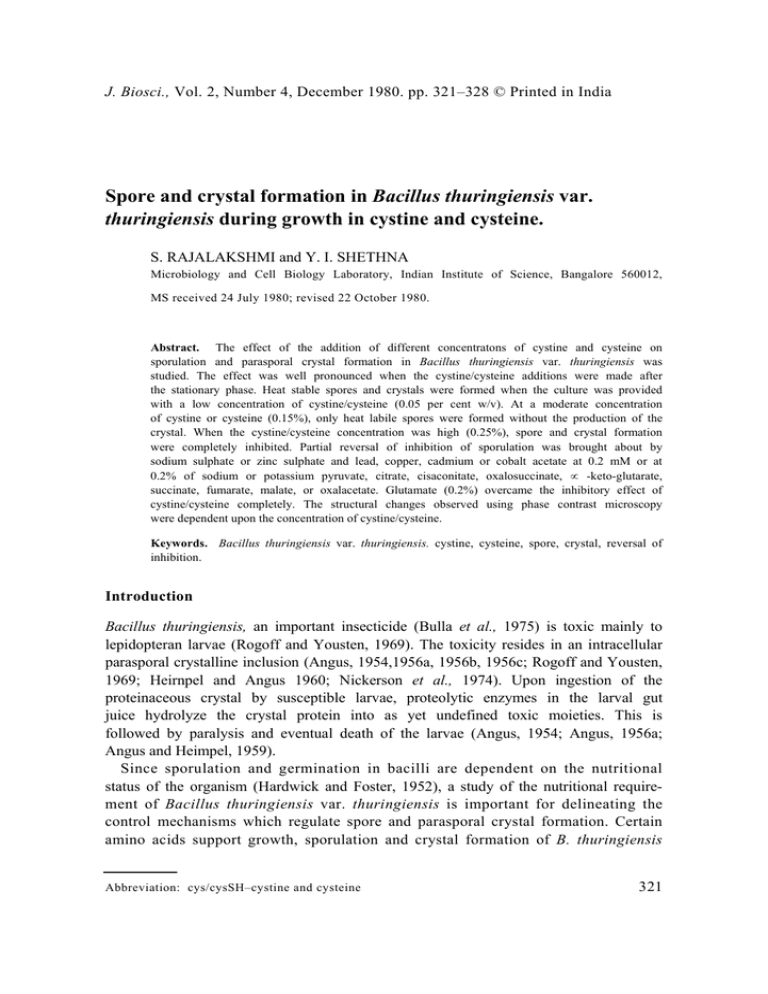
J. Biosci., Vol. 2, Number 4, December 1980. pp. 321–328 © Printed in India Spore and crystal formation in Bacillus thuringiensis var. thuringiensis during growth in cystine and cysteine. S. RAJALAKSHMI and Y. I. SHETHNA Microbiology and Cell Biology Laboratory, Indian Institute of Science, Bangalore 560012, MS received 24 July 1980; revised 22 October 1980. Abstract. The effect of the addition of different concentratons of cystine and cysteine on sporulation and parasporal crystal formation in Bacillus thuringiensis var. thuringiensis was studied. The effect was well pronounced when the cystine/cysteine additions were made after the stationary phase. Heat stable spores and crystals were formed when the culture was provided with a low concentration of cystine/cysteine (0.05 per cent w/v). At a moderate concentration of cystine or cysteine (0.15%), only heat labile spores were formed without the production of the crystal. When the cystine/cysteine concentration was high (0.25%), spore and crystal formation were completely inhibited. Partial reversal of inhibition of sporulation was brought about by sodium sulphate or zinc sulphate and lead, copper, cadmium or cobalt acetate at 0.2 mM or at 0.2% of sodium or potassium pyruvate, citrate, cisaconitate, oxalosuccinate, ∝ -keto-glutarate, succinate, fumarate, malate, or oxalacetate. Glutamate (0.2%) overcame the inhibitory effect of cystine/cysteine completely. The structural changes observed using phase contrast microscopy were dependent upon the concentration of cystine/cysteine. Keywords. Bacillus thuringiensis var. thuringiensis. cystine, cysteine, spore, crystal, reversal of inhibition. Introduction Bacillus thuringiensis, an important insecticide (Bulla et al., 1975) is toxic mainly to lepidopteran larvae (Rogoff and Yousten, 1969). The toxicity resides in an intracellular parasporal crystalline inclusion (Angus, 1954,1956a, 1956b, 1956c; Rogoff and Yousten, 1969; Heirnpel and Angus 1960; Nickerson et al., 1974). Upon ingestion of the proteinaceous crystal by susceptible larvae, proteolytic enzymes in the larval gut juice hydrolyze the crystal protein into as yet undefined toxic moieties. This is followed by paralysis and eventual death of the larvae (Angus, 1954; Angus, 1956a; Angus and Heimpel, 1959). Since sporulation and germination in bacilli are dependent on the nutritional status of the organism (Hardwick and Foster, 1952), a study of the nutritional requirement of Bacillus thuringiensis var. thuringiensis is important for delineating the control mechanisms which regulate spore and parasporal crystal formation. Certain amino acids support growth, sporulation and crystal formation of B. thuringiensis Abbreviation: cys/cysSH–cystine and cysteine 321 322 Rajalakshmi and Shethna var. thuringiensis, while others inhibit the growth (Singer et al., 1966; Singer and Rogoff, 1968; Bulla et al., 1975; Nickerson and Bulla, 1975; Rajalakshmi and Shethna, 1977). A lower concentration of cystine (Nickerson and Bulla, 1975) or cysteine (Rajalakshmi and Shethna, 1977) promotes growth, sporulation and crystal formation in Β. thuringiensis, while at a higher concentration of cys/cysSH, only the vegetative growth was observed, (Rajalakshmi and Shethna, 1977). We report here a detailed study of the effect of various concentrations as well as the time of addition of cys/cysSH on spore and crystal formation in Β. thuringiensis var. thuringiensis and the reversal of inhibition of sporulation by various compounds. Materials and methods Organism and culture conditions Bacillus thuringiensis Serotype I was obtained from Professor Η. de Barjac, Institute Pasteur, Paris, France. The culture was maintained on nutrient agar slants. The minimal medium and the inoculum were prepared as described earlier (Rajalakshmi and Shethna, 1977). Effect of cys/cysSH To study the effect of various concentrations of cys/cysSH the minimal medium containing 1% glucose was supplemented with 0.05, 0.1, 0.15, 0.2 and 0.25% of cys/cysSH, respectively. Growth, sporulation and crystal formation were monitored from time to time. Effect of addition of cys /cysSH after the stationary phase In another set of experiments, B. thuringiensis var. thuringiensis cells were grown in a minimal medium containing 1.0% glucose and 0.05% cys/cysSH. Different concentrations of cys/cysSH (i.e. 0.05, 0.1, 0.15 and 0.2%) were added at 0, 1, 2,3 and 4 h after the stationary phase was reached and their effects on spore and crystal formation were studied. Microscopic studies For phase contrast microscopy, control and experimental cells were harvested at the mid log phase and 10 h after the attainment of the stationary phase. The cells were washed and suspended in 0.1 Μ potassium phosphate buffer pH 7.2. A wet smear of the suspension was observed immediately under a light microscope (Zeiss photo microscope, W. Germany). Reversal of inhibition of sporulation A reversal of inhibition of sporulation, caused by cys/cysSH was effected by the addition of divalent cations, intermediates of the tricarboxylic acid cycle or glutamate individually. Sodium or zinc sulphate and lead, copper, cadmium and cobalt acetate were used (2 mM). Sodium or potassium puruvate, citrate, cis-aconitate, oxalosuccinate ∝-keto-glutarate, succinate, fumarate, malate, oxalacetate and glutamate were used at a concentration of 0.2% after filter sterilization. Additions were made 60 to 90 min prior to the stationary phase, when varying concentration of cys/cysSH was provided in the growth medium. Whereas, when Spore-crystal formation in Bacillus thuringiensis 323 the cys/cysSH additions were made after the stationary phase, the substances were added 10 to 15 min prior to the addition of excess cys/cysSH. Cys and cysSH, wherever mentioned, were used individually. Growth was monitored by measuring the absorbance at 600 nm in a Bausch and Lomb Spectronic-20 colorimeter. Sporulation and crystal formation were monitored by the observation of a wet smear of the culture under a phase contrast microscope (Zeiss dark phase contrast microscope). Heat-stable spores were estimated by a standard procedure (Nickerson and Bulla, 1975). When the cells were grown with low concentration of cys/cysSH (0.05%), heat-stable spores and crystals were produced; under such a condition, there was no heat-labile spore formation. When the cells were provided with a moderate concentration of cys/cysSH (0.15%), only heat labile spores were produced. The heat-labile spores were found to be susceptible to lysozyme treatment, whereas the heat-stable spores were not succeeptible to such treatment. The heat-labile spores were estimated by plating on nutrient agar plates after appropriate dilution. Heat lability and stability were confirmed by lysozyme treatment (Stahly et al., 1978). Cells grown 0.05% cys/cysSH and 1 % glucose were taken as the control for all the studies given under Materials and Methods. Toxicity of the crude cell lysate was checked by feeding the pellet obtained after centrifugation of the crude cell lysate at 8,000 g for 10 min, to the second or third instar larvae of silkworm moth (Bombyx mori). The crude pellet was suspended in distilled water, sprayed on mulberry leaf (1 mg protein) and fed to 20 larvae. Chemicals Intermediates of tricarboxylic acid cycle and glutamate were obtained from Sigma Chemical Co., St. Louis, Missouri, USA. L-Cystine, L-cysteine* and all the salts of divalent cations were obtained from E. Merck, Darmstadt, Germany. All the other chemicals were of Analar or Reagent grade. Results Spore and crystalformation in relation to cys/cysSH concentration The efficiency of spore and crystal formation was studied in relation to cys/cysSH concentration. It was noticed that in the control, as well as in the presence of cys/cysSH (0.05%), the efficiency of spore and crystal formation was 100 percent. At a concentration of 0.1% of cys/cysSH, the efficiency was drastically reduced. At 0.15 and 0.2% of cys/cysSH, only heat-labile spores were formed with complete inhibition of crystal formation. At 0.25% cys/cysSH, there was complete inhibition of spore and crystal formation in B. thuringiensis var. thuringiensis (figure 1). * Cysteine was freely soluble upto 0.112g/1 at25 °C. Whenever needed, it was solubilized with acid(0.1N HCl) and then added to the medium. The pH of the medium was adjusted to 7.2 after the cys/cysSH addition. (Reference: The Merck index of chemicals and drugs, 7th ed. Merck and Co. inc., Rahway, New Jersey, USA 1960.) 324 Rajalakshmi and Shethna Figure 1. Effect of cys/cysSH on spore and crystal fοrmation in B. thuringiensis var. thuringiensis. Heat-labile and heat-stable spores were calculated as given under Materials and Methods. Toxicity was checked by feeding to 2nd or 3rd instar silkworm (Bombyx mori) as mentioned in the text. SC-Heat stable spores and crystals. HLS-Heat labile spores. –SC: No spore and crystal. Since the absorbance increased with respect to cys/cysSH concentration, all the samples were diluted so as to obtain an absorbance equal to control (0.05 per cent cys/cysSH). After dilution, the number of spores per ml was estimated. Cystine, ( ■ );Cysteine, ( □ ). Effect of addition of cys/cysSHat the stationary phase It was noticed that when 0.05% of cys/cysSH was added at 0 h of the stationary phase, heat-stable spores and toxic cystals were formed. At0.1 and 0.15%, only heat-labile spores were produced with no crystal formation. Where as, when 0.2% of cys/cysSH was added, spore and crystals were not formed (table 1) microscopically, and the bioassay also showed no toxicity. Effect of addition of cys/cysSH after the stationary phase Sporulation and parasporal crystal formation were found to be inhibited even at the concentration of 0.15% of cys/cysSH when the addition was made 1 h after the onset of the stationary phase (table 1). The efficiency of sporulation decreased as the time of addition of excess cys/cysSH was increased. Spore-crystal formation in Bacillus thuringiensis 325 Table 1. Effect of addition of cys/cysSH after stationary hrase. O, t1, t2, t3, t4 represent the time of addition of cys/cysSH i.e., Ο h–at stationary phase; t1–1 h after stationary phase; t2–2 h after stationary phase etc. 10–12 h after the addition of cys/cysSH samples were removed and the number of spores were calculated. Toxicity was checked as per the text. Only when 0.05% cys/cysSH was added at t0 and t1, there was the formation of the heat stable spores and crystals. When 0.1% cys/cysSH was added after t2 and 0.15% cys/cysSH was added even at t0 only heat labile spores were produced without the crystal formation. For this addition experiment cells were grown with 1% glucose and 0.05% cys/cysSH. Microscopy The cells grown on cys/cysSH medium were thinner and longer than the control cells (figures 2a, 2b). Photomicrography revealed that the control cells grown with 0.05% cys/cysSH produced spores and crystals (figure 3). At moderate concentration of cys/cysSH (0.15%) only heat-labile spores were formed (figure 4). At high concentration (0.25%), both spore and crystal formation were found to be completely inhibited; besides, there was a change in the morphology of the experimental cells, about 15 to 29 min before lysis (figure 5). 326 Rajalakshmi and Shethna Figure 2. Photomicrograph of the control (2a), and the experimental (2b) cells at the late logarithmic phase. (magnification ×1800). Figure 3. Photomicrograph of the control cells 12 h after the stationary phase. S–Spore; C–Crystal, (magnification ×1400). Figure 4. Photomicrograph of the cells grown with 0.15% cys/cysSH. Micrograph taken 12 h after the stationary phase. S–Heat labile spore. (magnification ×1400). Figure 5. Photomicrograph of the cells grown with 0.25% cystine. Picture taken at 15 min before the lysis of the cells i.e., 8 h after the stationary phase, (magnification ×1400). Spore-crystal formation in Bacillus thuringiensis 327 Reversal of inhibition of sporulation caused by cys/cysSH Partial reversal of the inhibition of sporulation was observed on the addition of certain divalent cations as well as some of the intermediates of Krebs' cycle (figures 6,7). In addition, glutamate (0.2%) also brought about complete reversal of inhibition of sporulation (figure 7). Heat-stable spores and crystals were formed whenever the reversal of inhibtion was observed. Figure 6. Reversal of inhibition of sporulation caused by cys/cysSH by the addition of divalent cations. C–control grown with 1% glucose and 0.05% cys/cysSH; Na–sodium sulphate; Zn–Zinc sulphate; Co–Cobalt acetate; Pb– Lead acetate; Cu–Copper acetate; Cd–Cadmium acetate. Figure 7. Reversal of inhibition by Krebs cycle intermediates and glutamate. C–Control; 1–pyruvate; 2–citrate; 3–cis-aconitate; 4–isocitrate; 5–oxalosuccinate; 6–ketoglutarate; 7–succinate; 8–fumarate; 9–malate; l0–oxaloacetate; 11–glutamate. Heat-stable spores and crystals were produced whenever the phenomenon of reversal was observed. 328 Rajalakshmi and Shethna Discussion The reversal of inhibition caused by cys/cysSH on the addition of heavy metal salts could be occuring through a mechanism similar to that proposed for B. megaterium (Vinter, 1957). It was presumed that heavy metal ions reacted with H2S produced from cystine by the organism and hence led to the reversal of the inhibition of the sporulation. It is possible that cys/cysSH breakdown and incorporation were intensified by increased respiration (Vinter, 1957) in presence of intermediates of the tricarboxylic acid cycle leading to reversal of inhibition. Glutamate plays an important role during sporulation by acting as the primary energy source for the assimilation of acetate (Nakata and Halvorson, 1960) into parahydroxybutyrate (Charba and Nakata, 1977; Kennedy et al., 1971). The ability of glutamate to reverse the inhibition of sporulation and crystal formation could be due to an increased respiration, the induction of enzymes of the ã -amino butyric acid pathway, the incorporation and assimilation of acetate or the cumulative effect of all the three. Changes observed at the structural level (figures 2b, 5) could be due to a disturbance at the physiological level caused by excess cys/cysSH in the medium. Growth was enhanced as the concentration of cys/cysSH was increased in the medium, whereas only the spore and crystal formation were affected. The observed inhibition of sporulation could not be due to acidicity of the medium caused by cys/cysSH as the pH was maintained at 7.2 and the free amino acids rather than the hydrochlorides were used. The identical results obtained with cys and cysSH could be due to the fact that cysteine is first converted to cystine and then metabolized further. Acknowledgement We thank Dr. M. S. Shaila for many useful discussions and help in the preparation of the manuscript. References Angus, T. A. (1954) Nature (London)., 173, 545. Angus, T. A. (1956a) Can. J. Microbiol., 2, 111. Angus, Τ. A. (1956b) Can. J. Microbiol., 2, 122. Angus, Τ. A. (1956c) Can. J. Microbiol., 2, 416. Angus, Τ. Α. and Heimpel, A. (1959) Can. Entomologists, 91, 352. Bulla, L. A. Jr., Nickerson, Κ. W., Mounts, T, L. and Iandolo, J. J. (1975) In Spores VI, Amer. Soc. Microbiol. Wash. D.C. p. 520. Charba, J. F., and Nakata, Η. Μ. (1977) J. Bacteriol, 130, 242. Hardwick, W. A. and Foster, J. W. (1952) J. Gen. Physiol., 35, 907. Heimpel, Α. Μ. and Angus, T. Α. (1960) Bacteriol. Rev., 24, 266. Kennedy, R. S., Malveaux, F. J. and Cooney, J. J. (1971) J. Microbiol., 17, 511. Nakata, Η. Μ. and Halvorson, Η. Ο. (1960) J. Bacteriol., 80, 801. Nickerson, Κ. W. and Bulla, L. A. (1975) J. Bacteriol., 123, 598. Rajalakshmi, S. and Shethna, Y. I. (1977) J. Ind. Inst. Sci., 59, 169. Rogoff, Μ. Η. and Yousten, A. A. (1969) Ann. Rev. Microbiol., 23,.357. Singer, S., Goodman, Ν. S. and Rogoff, Μ. Η. (1966) Ann. New York. Acad. Sci., 139, 16. Singer, S. and Rogoff, Μ. Η. (1968) J. Invertebrate. Pathol., 12, 98. Stahly, D. P., Dingman, D.W., Bulla, L. A. Jr. and Aronson, A. I. (1978) Biochem. Biophys. Res. Commun., 84, 581. Vinter, V. (Ceskoslovenska. Ved. Prah.) (1957a), Ceskoslovenska. Microbiol, 2, 246. Vinter, V. (Czechoslovak. Acad. Sci. Prague) (1957b), J. Appl. Bacteriol., 20, 325.
